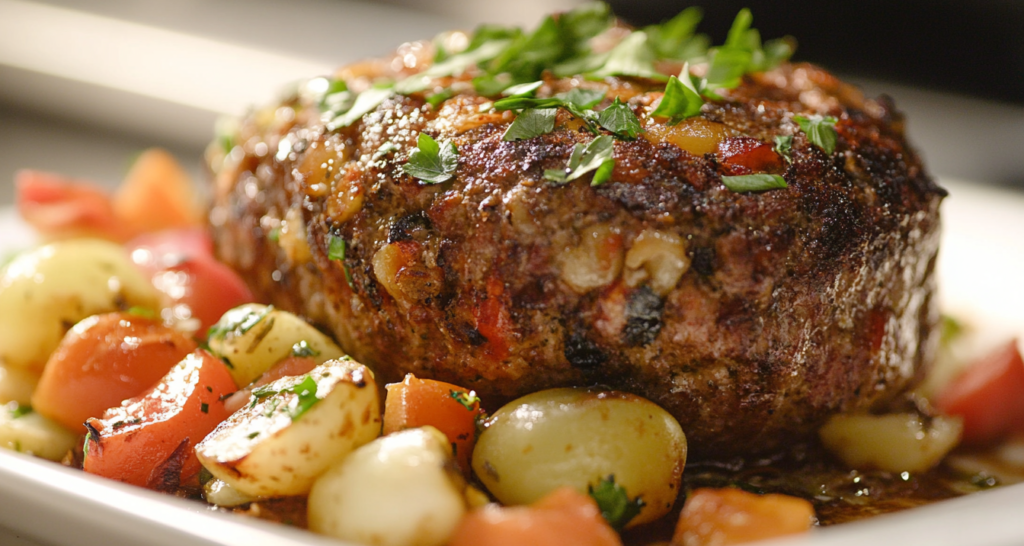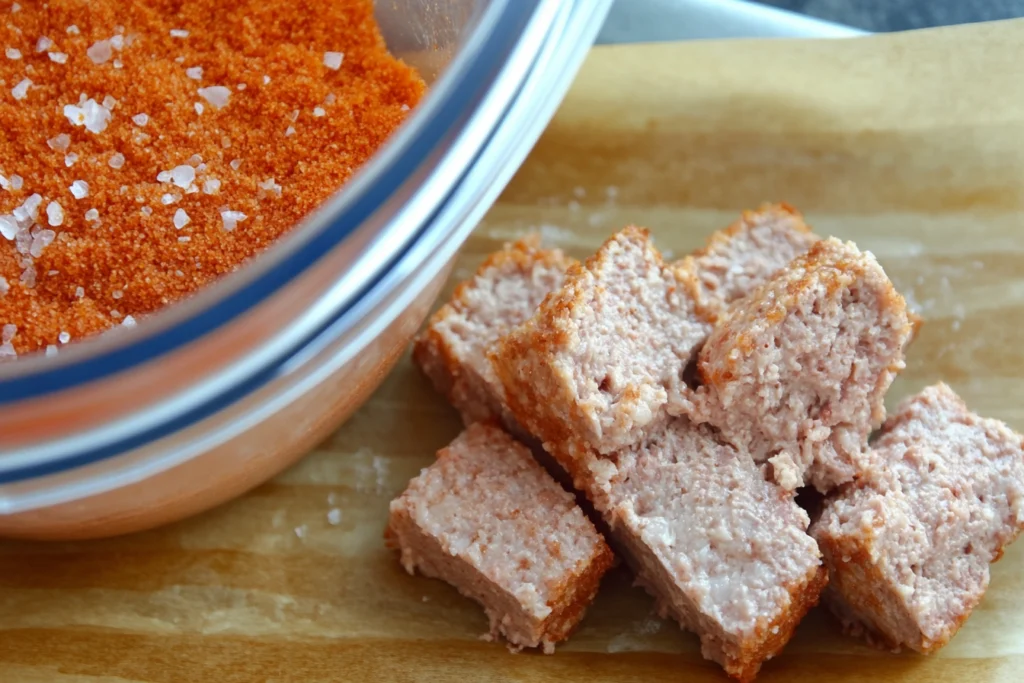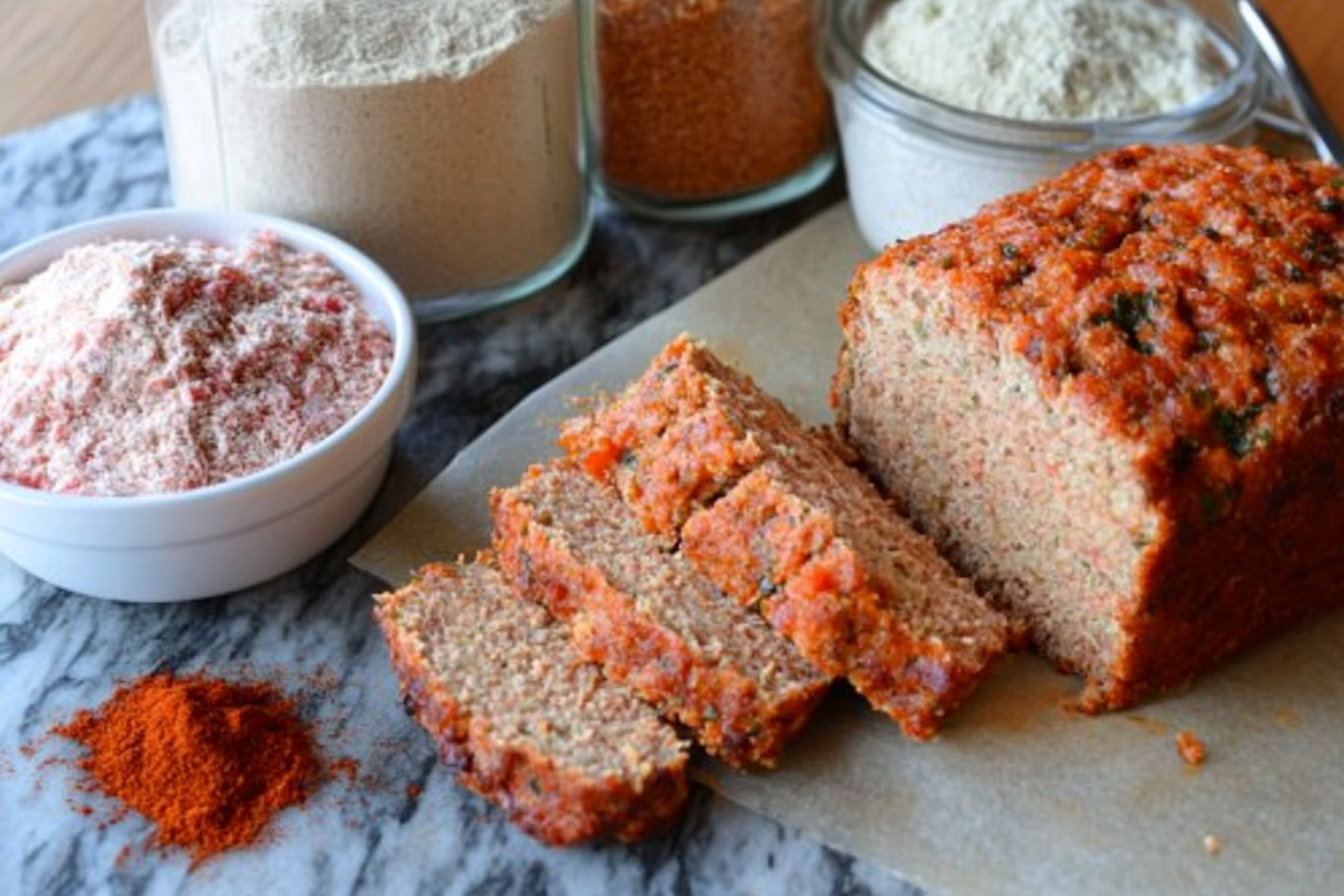Meatloaf, a timeless comfort food, has been gracing dinner tables across the globe for decades. Its versatility, affordability, and heartwarming appeal make it a favorite among families. However, a common challenge is ensuring that this dish isn’t just filling, but also packed with flavor. If you’re looking to elevate your meatloaf game, this comprehensive guide will walk you through the art of making it flavorful, aromatic, and utterly delicious.
Part 1: Basics and Key Ingredients
1. Introduction to Meatloaf
Meatloaf is a dish typically made of ground meat combined with binders and seasonings, shaped into a loaf, and baked to perfection. It’s believed to have originated in Europe, where similar dishes were crafted centuries ago. Today, meatloaf is a staple in American households, beloved for its customizability and simplicity.
Why is meatloaf so popular? Its adaptability. Whether you’re working with beef, pork, turkey, or even plant-based alternatives, there’s a meatloaf recipe for everyone.
2. The Foundation of a Flavorful Meatloaf
The key to a mouthwatering meatloaf lies in balancing the meat, fillers, and flavorings.
- Meat Mix: Choosing the right blend of ground meat is crucial. While beef adds richness, pork contributes fat and moisture. For a leaner option, mix turkey or chicken with small amounts of fattier meat to avoid dryness.
- Fillers: Bread crumbs, oats, or crackers absorb juices, ensuring the loaf doesn’t crumble. However, they should never overpower the dish.
3. Aromatics as Flavor Enhancers
Aromatics bring depth to your meatloaf.
- Onions and Garlic: Sautéing onions and garlic softens their bite and releases their natural sweetness, elevating the overall flavor.
- Bell Peppers and Celery: These add a subtle crunch and earthy undertones. Finely dice them to blend seamlessly into the mixture.
Pro Tip: Always sauté aromatics before mixing them into your meat for a softer texture and better flavor integration.
4. Adding Herbs for Aroma
Herbs and spices are the soul of any seasoned meatloaf.
- Fresh vs. Dried: While fresh herbs like parsley and thyme deliver a vibrant aroma, dried herbs like oregano and basil can intensify the flavor due to their concentrated oils.
- Spices: Paprika adds a smoky edge, cayenne delivers a spicy kick, and cumin provides earthy warmth. Use a blend tailored to your preferences.
5. Sauces and Liquids to Bind and Flavor
Moisture is essential for a tender meatloaf. Choosing the right liquid can significantly impact the flavor profile.
- Tomato Paste: Offers a rich, concentrated flavor.
- Ketchup and BBQ Sauce: Bring a tangy sweetness that pairs perfectly with savory meat.
- Worcestershire Sauce: Adds a depth of umami, while soy sauce can offer a hint of saltiness. Stock (chicken, beef, or vegetable) keeps the mixture moist without overpowering.
6. Cheese for Richness
Cheese lovers rejoice! Adding cheese can take your meatloaf to the next level.
- Mixed In: Shredded cheddar or Parmesan melts into the meat, creating pockets of gooey goodness.
- As a Topping: A cheesy crust (e.g., mozzarella) caramelizes beautifully, adding texture and a burst of flavor.
7. Bread Crumbs and Alternatives
The role of bread crumbs or their substitutes is not just structural but also flavorful.
- Seasoned Bread Crumbs: Infuse your meatloaf with subtle flavors like garlic, onion, and herbs.
- Alternatives: Oats offer a hearty texture, while crushed crackers or panko lend a delicate crunch.
Pro Tip: Avoid overloading fillers, as they can dilute the flavor of the meat.
8. Eggs as Binding Agents
Eggs act as the glue that holds your meatloaf together.
- Egg’s Role: They bind the ingredients, ensuring your meatloaf doesn’t fall apart during cooking or slicing.
- Substitutes: For egg-free recipes, use flaxseed meal mixed with water or unsweetened applesauce.

9. Sweet and Tangy Glazes
A glaze is the finishing touch that turns a good meatloaf into a masterpiece.
- Classic Glaze: A mixture of ketchup, brown sugar, and vinegar adds a sweet, tangy contrast to the savory meat.
- Creative Variants: Experiment with honey-mustard, balsamic reductions, or spicy chili glazes for a unique twist.
10. Infusing Bold Flavors
For those who crave adventure in their food, bold spices and international influences are the way to go.
- Chili Flakes and Mustard Powder: These pack heat and tang, adding complexity to the flavor.
- Global Spices: Curry powder brings an Indian-inspired flair, while harissa paste adds a North African kick.
How to Add Flavor to Meatloaf (Continued)
Part 2: Advanced Techniques and Variations
1. Layering Flavors with Fillings
One way to take your meatloaf to the next level is by adding flavorful fillings. These not only surprise the palate but also enhance texture.
- Vegetable Fillings: Roasted mushrooms, spinach, or caramelized onions add moisture and depth. Roasted red peppers bring a hint of sweetness and color.
- Bacon or Ham Wraps: Wrapping meatloaf in bacon or prosciutto enhances the smoky and salty profile while sealing in moisture.
Pro Tip: Use a uniform layer of fillings to prevent uneven cooking and to keep the flavors balanced throughout.
2. Marinades and Seasonings Before Cooking
Marinating or pre-seasoning the meat mixture can significantly enhance the flavor profile of your meatloaf.
- Marinades: Mix Worcestershire sauce, garlic powder, and a splash of soy sauce into the ground meat and let it rest for at least 30 minutes before cooking.
- Seasoning Mixtures: Toast dry spices like paprika, cumin, or mustard powder to release their oils, then mix them into the meat for a deeper, more aromatic flavor.
3. Creative Glazing Techniques
The glaze on a meatloaf is the crown jewel, providing a balance of sweet, tangy, and savory flavors.
- Double-Glazing Method: Apply one layer halfway through baking and another layer just before the end. This technique ensures a rich, caramelized crust.
- Special Glazes: Experiment with honey-soy glaze, chili-infused maple syrup, or balsamic reductions to make the dish stand out.
4. Smoking and Grilling Meatloaf
For a meatloaf with a distinct smoky flavor, turn to outdoor cooking methods.
- Smoking: Use wood chips like mesquite or applewood to impart a deep, earthy flavor. Smoke the meatloaf at a low temperature for about 2–3 hours.
- Grilling: Shape smaller loaves or patties for grilling. Brush them with oil and glaze to ensure they remain juicy and flavorful.
5. Incorporating Fruits for Sweetness
Fruits provide a natural sweetness that complements the savory profile of meatloaf.
- Fresh Fruits: Diced apples, pears, or chopped dates add a delicate sweetness.
- Dried Fruits: Cranberries, raisins, or apricots work wonderfully in pork or turkey-based meatloaf recipes.
- Citrus Zest: Lemon or orange zest introduces brightness and balances heavier flavors.
6. Alternative Protein Sources
Switching the main protein in your meatloaf can create a completely new experience.
- Ground Poultry: Ground turkey or chicken is a lighter option. To prevent dryness, mix with grated vegetables like zucchini or carrots.
- Plant-Based Options: Combine lentils, chickpeas, or plant-based ground meat alternatives with bold spices and vegetable binders for a vegan take.
- Seafood Meatloaf: Ground salmon or crab mixed with breadcrumbs and herbs offers a fresh, coastal twist.

7. International Meatloaf Styles
Borrowing from global cuisines adds variety to your repertoire.
- Italian Meatloaf: Incorporate marinara sauce, Italian seasoning, and mozzarella cheese, and top with Parmesan crust.
- Asian-Inspired Meatloaf: Use ginger, garlic, soy sauce, and sesame oil, then finish with a hoisin glaze.
- Mexican Meatloaf: Mix in cumin, chili powder, and cilantro, and layer with cheese. Serve with salsa or guacamole for a bold finish.
8. Layered Meatloaf Variations
Layering brings both visual appeal and a delightful mix of flavors.
- Mashed Potato Layer: Spread a layer of creamy mashed potatoes in the middle for a hearty surprise.
- Stuffing Layers: Use seasoned stuffing or polenta to create unique textures and flavors.
- Cheese Layers: Create alternating layers of meat and your favorite cheese for gooey pockets in every slice.
9. Cooking Method Influences
The way you cook meatloaf affects its flavor and texture significantly.
- Oven-Baking: Traditional and reliable, oven baking ensures even cooking. Use a loaf pan for uniformity or shape the loaf freeform for more crust.
- Slow Cooking: A slow cooker enhances tenderness as the meatloaf cooks in its juices. This method is ideal for a hands-off approach.
- Sous Vide: For ultimate precision, sous vide keeps the meatloaf moist while locking in flavors. Sear it afterward for a caramelized crust.
10. Garnishes and Presentation
Elevate your meatloaf with thoughtful garnishing and plating.
- Herb Garnishes: Sprinkle freshly chopped parsley, cilantro, or dill for a burst of freshness.
- Cheese or Sauce Drizzles: Drizzle extra glaze, a cheesy béchamel, or spicy aioli on top before serving.
- Creative Plating: Slice the meatloaf and serve it atop mashed potatoes or alongside a bright green salad for a balanced meal.
can create a meatloaf that’s anything but ordinary. Experiment with flavors, explore global influences, and enjoy the ultimate comfort food at its finest.
How to Add Flavor to Meatloaf (Continued)
Part 3: Tips, Tricks, and Troubleshooting
1. Common Mistakes in Meatloaf Making
While meatloaf is a simple dish at its core, it’s easy to fall into common pitfalls. However, these can be avoided with a few tweaks:
- Overmixing: This is a frequent mistake that results in a dense, chewy texture. Instead, gently combine the ingredients just until they are evenly distributed.
- Uneven Cooking: An uneven loaf shape can cause the edges to overcook while the center remains underdone. Therefore, aim for a uniform thickness.
- Dryness: If your meatloaf tends to dry out, it’s likely due to either overbaking or not using enough moist ingredients like eggs, milk, or grated vegetables.
To ensure success, always use a meat thermometer to check for doneness: 160°F (71°C) for beef or pork and 165°F (74°C) for poultry.
2. Adjusting Seasoning to Taste
Seasoning is crucial to achieving a flavorful meatloaf. Surprisingly, many home cooks overlook the importance of testing their mix beforehand.
- Taste Test Method: To avoid seasoning mishaps, fry a small portion of the meat mixture and taste it. This way, you can adjust the flavors before baking the entire loaf.
- Balancing Act: If the mixture is too salty, adding extra breadcrumbs or vegetables can help dilute the flavor. Conversely, if it’s bland, a dash of Worcestershire sauce, soy sauce, or mustard can elevate the taste.
3. Perfecting the Texture
Achieving the perfect texture for your meatloaf may seem challenging, but with the right techniques, it’s quite manageable.
- Binder Ratio: The golden rule is to use 1 cup of filler (like breadcrumbs or oats) and one egg per pound of ground meat.
- Moisture Boosters: Grated vegetables, such as zucchini or carrots, not only enhance texture but also add natural moisture.
- Resting Period: After baking, let the meatloaf rest for 10–15 minutes. This step allows the juices to redistribute, ensuring every slice is moist.

4. Gluten-Free and Keto Adaptations
For those with dietary restrictions, it’s reassuring to know that meatloaf can be easily adapted.
- Gluten-Free Options: Substitute traditional breadcrumbs with almond flour, gluten-free crackers, or cooked quinoa.
- Keto-Friendly Adjustments: Replace sugary glazes with alternatives like a tangy mustard or sugar-free tomato sauce.
These simple swaps ensure everyone at the table can enjoy a flavorful meatloaf.
5. Storing and Reheating Meatloaf
Proper storage and reheating are essential to maintaining the quality of leftovers.
- Storage Tips: Wrap leftover meatloaf tightly in foil or place it in an airtight container. Refrigerate for up to 4 days or freeze for up to 3 months.
- Reheating: To avoid drying it out, reheat slices in a covered dish with a splash of water or stock in an oven preheated to 325°F (163°C). Alternatively, use a microwave with a damp paper towel over the plate for a quicker option.
6. Meal Prep and Batch Cooking
Interestingly, meatloaf is a fantastic dish for meal prep.
- Batch Cooking: Prepare multiple meatloafs at once. Freeze uncooked loaves in plastic wrap and aluminum foil. When ready to cook, thaw in the refrigerator and bake as directed.
- Single Servings: For convenience, shape the mixture into muffin tins for individual portions that can be easily reheated during the week.
7. Pairing Meatloaf with Sides
While meatloaf is the star of the meal, the sides play an important supporting role.
- Classic Pairings: Mashed potatoes, green beans, or roasted carrots are timeless choices that complement the rich flavors of meatloaf.
- Creative Combinations: For something different, serve meatloaf with a quinoa salad, grilled asparagus, or a tangy coleslaw.
- Sauces and Gravies: A creamy mushroom sauce or a spicy aioli can elevate the dish even further.
8. Kids-Friendly Flavor Adjustments
Interestingly, minor tweaks can make meatloaf more appealing to younger palates.
- Mild Seasonings: Reduce the amount of strong spices like cayenne or chili powder. Stick to herbs such as parsley, oregano, or thyme for subtle flavor.
- Hidden Vegetables: Grating carrots, zucchini, or spinach into the mix ensures added nutrition without detection.
- Cheesy Touch: Adding a layer of cheese or mixing in shredded cheddar makes the dish more appealing to kids.
9. Vegan and Plant-Based Meatloaf
Even without meat, it’s possible to create a hearty and satisfying meatloaf.
- Key Ingredients: Lentils, chickpeas, or black beans serve as excellent bases for a plant-based loaf.
- Flavor Boosters: Nutritional yeast, soy sauce, and smoked paprika mimic the umami flavor of traditional meatloaf.
- Binding Agents: Flaxseed meal mixed with water or mashed potatoes works as a substitute for eggs.
10. Transforming Leftovers
Lastly, leftovers don’t have to be boring. With a little creativity, they can be turned into entirely new dishes.
- Meatloaf Sandwiches: Layer slices of meatloaf between toasted bread with mustard, lettuce, and pickles for a quick and satisfying lunch.
- Breakfast Hash: Dice the leftover meatloaf and sauté it with potatoes, onions, and eggs for a hearty morning meal.
- Casseroles: Crumble meatloaf into marinara sauce and mix with pasta for an easy and delicious casserole.
- Tacos or Wraps: Use crumbled meatloaf as a filling for tacos or lettuce wraps. Add your favorite toppings for a fresh take.
More FAQs
11. Can I bake meatloaf at a higher temperature?
Yes, but lower temperatures like 350°F (175°C) are ideal for even cooking. Baking at higher temperatures can dry out the meatloaf.
12. How do I get a crispy crust on my meatloaf?
Brush the top with glaze or melted butter, and bake uncovered for the last 15 minutes.
13. What’s the best way to test seasoning before baking?
Cook a small patty of the meat mixture in a skillet to taste and adjust seasoning.
14. Can I make meatloaf without binders?
Binders are essential for structure. However, you can experiment with alternatives like cooked grains or shredded vegetables.
15. How do I reduce grease in my meatloaf?
Use leaner meat or bake the loaf on a wire rack to allow the grease to drain.
16. Can I add fruit to meatloaf?
Yes, dried cranberries, apples, or raisins can provide a sweet counterbalance to the savory flavors.
17. How long should I rest meatloaf after baking?
Rest for 10–15 minutes to allow the juices to redistribute.
18. Can I use plant-based ground meat?
Absolutely! Use plant-based proteins like Beyond Meat or Impossible Meat for a vegan-friendly option.
19. What’s the best way to slice meatloaf?
Use a sharp knife and slice only after the meatloaf has rested to prevent crumbling.
20. Can I add alcohol for flavor?
Yes, a splash of red wine or whiskey in the glaze can add a rich, complex flavor.
With these detailed tips, advanced techniques, and frequently asked questions addressed, you’re now fully equipped to master the art of making a flavorful, perfectly textured meatloaf. From classic variations to innovative twists, the possibilities are endless!

